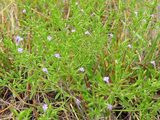Native Plants

Q. Who is Mr. Smarty Plants?
A: There are those who suspect Wildflower Center volunteers are the culpable and capable culprits. Yet, others think staff members play some, albeit small, role. You can torture us with your plant questions, but we will never reveal the Green Guru's secret identity.
Did you know you can access the Native Plant Information Network with your web-enabled smartphone?
Ask Mr. Smarty Plants is a free service provided by the staff and volunteers at the Lady Bird Johnson Wildflower Center.

rate this answer
Wednesday - February 19, 2014
From: Rosanky, TX
Region: Southwest
Topic: Erosion Control, Groundcovers, Grasses or Grass-like
Title: Native plants and grasses for river bank from Rosanky TX
Answered by: Barbara Medford
QUESTION:
Our property owners association would like to know what native plants/grasses to plant on the Blanco River bank in our river park to help prevent erosion. Some banks are steep and some areas are a gradual slope. Members want to know if it is preferable to leave downed trees and flood debris where they fall to prevent future erosion or if the better plan is to remove them and plant new trees and grasses. Our main goals are to protect our riverbank while also making sure property owners have access to enter the river and enjoy the water. Thank you for your help!ANSWER:
To answer your last question first, we would never recommend leaving debris, including fallen trees, on the ground. After all, you are in Bastrop County, and we understand we are already entering a period of Fire Danger warnings in Central Texas. Plus, it would be more difficult to plant and care for groundcovers with that debris present.
You mentioned steep banks but did not tell us about the sunlight available, so we are going to do a combination search on our Native Plant Database for groundcovers - some will be low and some will be high, so you will need to follow each plant link to our webpage on that plant, paying special attention to the growing conditions of each. We will check each to make sure it is native to your area before we add it to the list. Follow each plant link to our webpage on that plant, comparing water needs, size and growing conditions with what you are looking for.
First, some groundcovers that will do all right without too much sun - From a previous Mr. Smarty Plants answer for Austin:
Low groundcovers for part shade to shade in Central Texas:
Carex planostachys (Cedar sedge)
Low herbaceous blooming plants for part shade to shade in Central Texas.
Amblyolepis setigera (Huisache daisy)
Callirhoe involucrata (Winecup)
Calyptocarpus vialis (Straggler daisy)
Chamaecrista fasciculata (Partridge pea)
Dichondra argentea (Silver ponyfoot)
Glandularia bipinnatifida (Purple prairie verbena)
Hedeoma drummondii (Drummond's false pennyroyal)
Now, here are some taller grasses, for varying amounts of sun:
Andropogon gerardii (Big bluestem)
Aristida purpurea (Purple threeawn)
From the Image Gallery
More Groundcovers Questions
Turf grass for part-time home from Louisville KY
April 28, 2012 - We have a small yard at a remote location with cistern water, and need a turf grass for a yard, clay soil, which I am willing to amend. It will receive sporadic attention as my husband and I do not l...
view the full question and answer
Groundcover for Shady Front Beds in OK
July 15, 2014 - I need a groundcover for my front beds in Edmond, OK that are moist and in full shade. The groundcover would primarily be around and under a Japanese maple. Low maintenance is preferred.
view the full question and answer
Competition between Horseherb and Chickweed
July 04, 2014 - Ok, sorry I did it wrong the 1st time!? I live in Houston, and I have chickens! I also have mass amounts of Horseherb, and I want to buy some chickweed seeds and plant it for my chickens! My question ...
view the full question and answer
Replacing St. Augustine with Horse herb in Austin, TX.
December 12, 2012 - I'm considering replacing my St. Augustine grass with a Horseherb/Straggler Daisy ground cover, but I've heard that it provides a mosquito breeding habitat, especially if you allow dead leaves to de...
view the full question and answer
Native Groundcover for High Activity Location in Austin, TX
October 01, 2010 - Howdy! We live in South Austin and have a smallish backyard that we're perennially working on. We have two young, very active dogs that spend a lot of time RUNNING and we never can keep ground cover ...
view the full question and answer
| Support the Wildflower Center by Donating Online or Becoming a Member today. |

